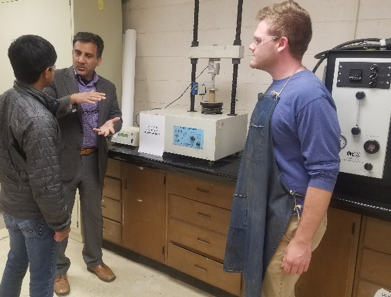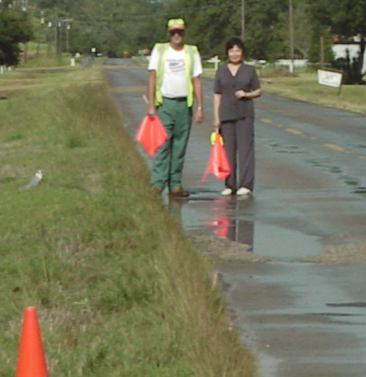Research
The faculty members of the Department of Civil Engineering are internationally known for their research on solving engineering challenges that can positively change the world. This research often includes significant student involvement at both the graduate and undergraduate student levels. Each year the department’s annual research expenditures exceeds $1M/year and more recently $2M/year.
The research facilities of the department are extensive and well equipped to support these efforts. In fact, recently, the department opened the newly renovated Franks International Hydraulics and Geoengineering Laboratory ($750K renovation), the newly constructed large materials testing facility (over $1.5M), the Transportation Safety Research Laboratory, and the Materaisl Testing and Environmental Engineering Laboratories.
A lot of positive are changes underway here in the Department of Civil Engineering. Please consider visiting! Or better yet, joining our exciting R&D teams as a student or faculty member.
The Key Research & Development (R&D) Areas of Activity Within the Department Include the Following Seven Areas:
Coastal Protection and Resiliency
Louisiana has sustained, and continues to sustain, tremendous land loss due to erosion caused by daily wave activity and further accelerated by storm events. R&D activities include computer modeling of hydrologic processes, development of shore protection devices, and field monitoring of ecological changes. The department is also very active with how storms are managed from a variety of factors including human safety and evacuation, prediction of water displacement, degradation of transportation systems, managing of business operations, and adverse ecological changes. Example funding sources for these activities include the National Science Foundation, US Army Corps of Engineers, Department of Homeland Security, and the Louisiana Department of Natural Resources.

Field testing of the Wave-Robber on the Louisiana Coast (this device protects the shoreline from erosion while replenishes the area with trapped sand
Environmental Engineering
The protection of our natural resources is a key research area for the Department of Civil Engineering. Treatment of contaminated environmental media, such as water, soils, and air, using innovative treatment systems are of great interest to our faculty. Recent example projects include treatment of fish processing wastewater using anaerobic biotreatment, removal of organic pollutants using natural and engineered polymeric adsorbents, degradation of explosives within contaminated groundwaters using advanced oxidation processes, and the management of human-derived wastes on future Mars planetary manned camps. Funding sources for these efforts include the Louisiana Board of Regents, NASA, and numerous private sector industries.

Anaerobic digestion pilot system for the study of reducing waste sludge at wastewater treatment plants
Construction Materials Development and Optimization
The continued development of modern, cost-effective constructed systems to house, transport, and support humans is based on the use of construction materials such as concretes, steel, wood, and composites. The department is very active in the formulation and optimization use of these materials in the construction of a wide variety of designed systems (buildings, bridges, roads, etc.). Funding sources for these activities come from a variety of sources including the Louisiana Department of Transportation and Development, National Science Foundation, Louisiana Board of Regents, and the private sector.

Improving construction materials performance through optimized mix formulations
Flood Protection
The State of Louisiana, due to its locality to both fresh and saltwater sources, has and will sustain damage to both humans and supporting infrastructural systems from flood events. The department has been a national leader in the development of computer models to predict and management flood events (and riverine systems in general), disaster management during flood events, the use of multi-modal precipitation sensor systems to better predict pending storm events, and the design for improved regional hydrologic drain systems. Funding sources for these activities include the National Science Foundation, Louisiana Board of Regents, and US Army Corps of Engineers.

Field monitoring of a riverine system
Transportation Engineering
The department has been involved in both the design of the constructed materials making up roadways and developing methods to improve the safety associated with the built road systems. Our research ranges from implementing improved methods to construct to the use of novel components of the construction materials to discovering layout of a wide variety of devices to reduce the loss of human life within reasonable costs. Funding sources for this work include the Federal Highway Administration, the Louisiana Department of Transportation and Development, and the Louisiana Board of Regents.

Evaluating the impact of edge lines on highway safety performance
Structural and Architectural Engineering
Faculty from the Civil Engineering Department perform research on how to provide the structural components of built infrastructural systems, such as high-rise buildings, bridges, and cranes. The design of structural members include materials of construction, fastening and bonding methods, modeling of load and system responses, and the inspection of aging structures. Funding for these R&D activities for the department has come from the National Science Foundation, US Federal Highway Administration, the Louisiana Department of Transportation and Development, and the Louisiana Board of Regents.

Inspecting the structural integrity of a structure
Alternative Energy from Waste Products
Several Civil Engineering faculty members are actively involved in the conversion of waste materials into energetic products, such as biogas and biodiesel, along with the production of value-added co-products from these conversions. Example projects include producing biogas from the anaerobic degradation of food wastes from institutional cafeterias, producing biodiesel from biosolids, and production of lipids during the aerobic biotreatment of wastewaters. Recent and current funding sources for these R&D efforts include the Department of Energy, National Science Foundation, Louisiana Board of Regents, NASA, and several private sector industries.

